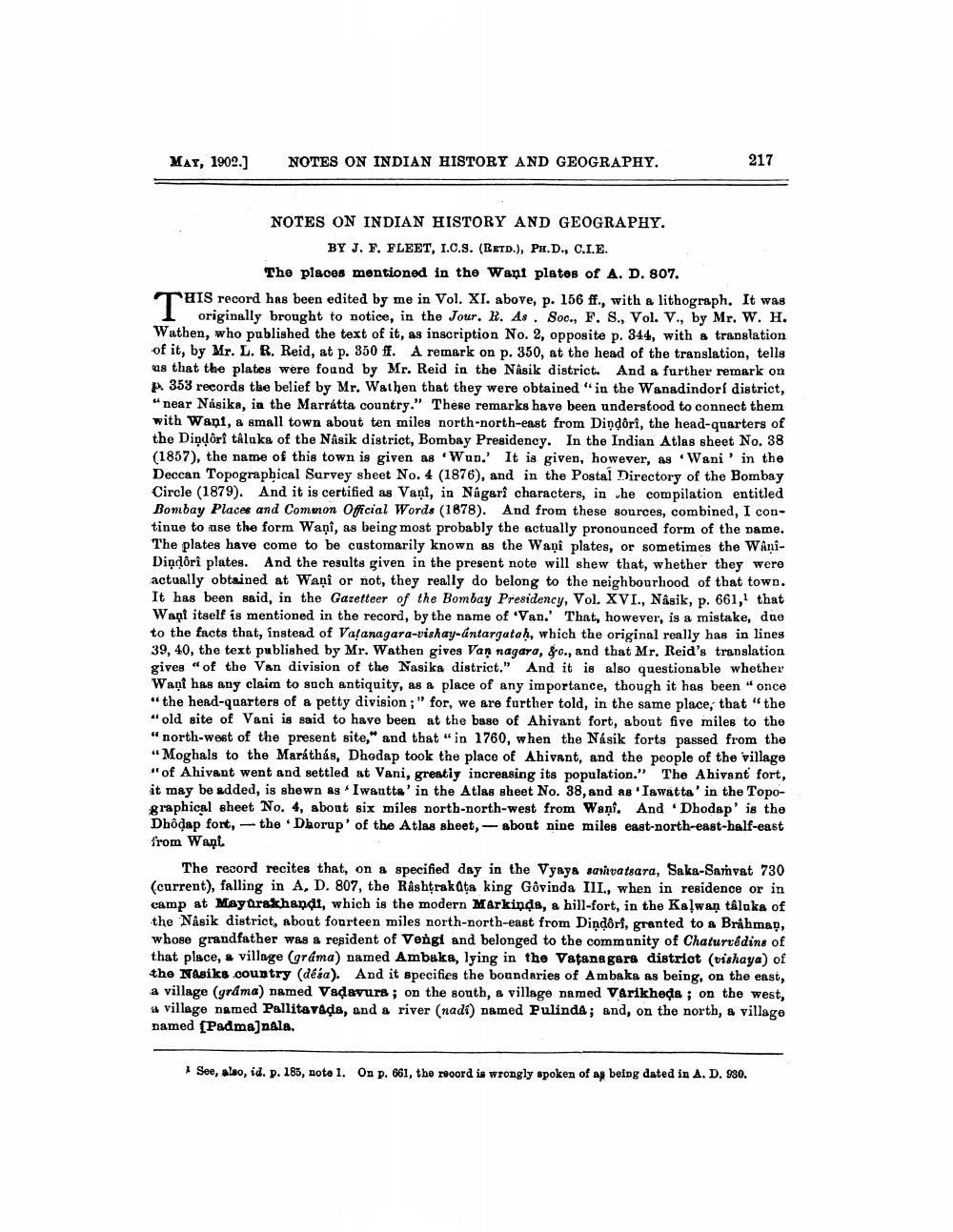________________
MAY, 1902.]
NOTES ON INDIAN HISTORY AND GEOGRAPHY.
217
NOTES ON INDIAN HISTORY AND GEOGRAPHY.
BY J. F. FLEET, I.C.S. (RETD.), PH.D., C.I.E.
The places mentioned in the Want plates of A. D. 807. THIS record has been edited by me in Vol. XI. above, p. 156 ff., with a lithograph. It was
1 originally brought to notice, in the Jour. R. As. Soc., F. S., Vol. V., by Mr. W. H. Wathen, who published the text of it, as inscription No. 2, opposite p. 344, with a translation of it, by Mr. L. R. Reid, at p. 350 ff. A remark on p. 350, at the head of the translation, tells as that the plates were found by Mr. Reid in the Nâsik district. And a further remark on
353 records the belief by Mr. Wathen that they were obtained in the Wanadindori district, near Násika, in the Marrátta country." These remarks have been understood to connect them with Wani, a small town about ten miles north-north-east from Dindori, the head-quarters of the Diņdôri taluka of the Nasik district, Bombay Presidency. In the Indian Atlas sheet No. 38 (1857), the name of this town is given as Wun. It is given, however, as Wani' in the Deccan Topographical Survey sheet No. 4 (1876), and in the Postal Directory of the Bombay Circle (1879). And it is certified as Vani, in Nagari characters, in whe compilation entitled Bombay Places and Common Official Words (1878). And from these sources, combined, I continue to use the form Wani, as being most probably the actually pronounced form of the name. The plates have come to be customarily known as the Waņi plates, or sometimes the WaniDiņdôrî plates. And the results given in the present note will shew that, whether they were actually obtained at Wani or not, they really do belong to the neighbourhood of that town. It has been said, in the Gazetteer of the Bombay Presidency, Vol. XVI., Nasik, p. 661,that Want itself is mentioned in the record, by the name of "Van.' That, however, is a mistake, due to the facts that, instead of Varanagara-vishay-ántargatah, which the original really has in lines 39, 40, the text published by Mr. Wathen gives Van nagara, &-c., and that Mr. Reid's translation gives of the Van division of the Nasika district." And it is also questionable whether Wani has any claim to such antiquity, as a place of any importance, though it has been once "the head-quarters of a petty division;" for, we are further told, in the same place, that "the "old site of Vani is said to have been at the base of Ahivant fort, about five miles to the "north-west of the present site," and that "in 1760, when the Násik forts passed from the "Moghals to the Maráthás, Dhodap took the place of Ahivant, and the people of the village "of Ahivant went and settled at Vani, greatiy increasing its population." The Ahivant fort, it may be added, is shewn as Iwantta' in the Atlas sheet No. 38, and as 'Iawatta' in the Topographical sheet No. 4, about six miles north-north-west from Wani. And Dhodap' is the Dhôdap fort, the Dhorup' of the Atlas sheet, - about nine miles east-north-east-half-east from Wapi.
The resord recites that, on & specified day in the Vysya sasivatsara, Saka-Samvat 730 (current), falling in A, D. 807, the Rashtrakata king Govinda III., when in residence or in camp at Mayarakhandi, which is the modern Markinda, a hill-fort, in the Kaļwan tâluka of the Násik district, about fourteen miles north-north-east from Dindorf, granted to a Brahmaộ, whose grandfather was a resident of Vengi and belonged to the community of Chaturvēdins of that place, a village (gráma) named Ambaka, lying in the Vatana gara distriot (vishaya) of the Nasiks country (désa). And it specifies the boundaries of Ambaka as being, on the east, a village (grama) named Vadavura; on the south, a village named Varikheda ; on the west, a village named Pallitavada, and a river (nadi) named Pulinda; and, on the north, a village named (Padmajnala.
See, alo, id. p. 185, noto 1. On p. 661, the record is wrongly spoken of ap being dated in A. D. 930.




